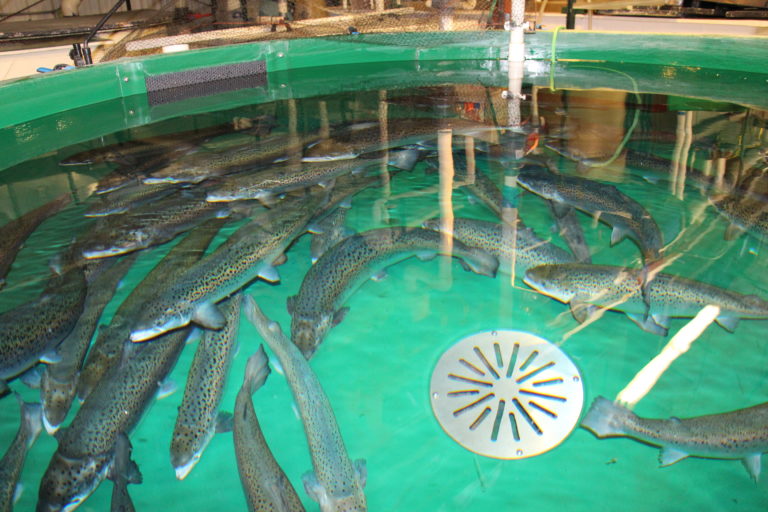
Frequently Asked Questions (FAQ)
The following are commonly asked questions regarding aquaculture in the United States.
You can expand any of the following tabs to reveal the answers.
Federal agencies including the Department of Agriculture (USDA), the Environmental Protection Agency (EPA), the National Oceanic and Atmospheric Administration (NOAA), the Fish and Wildlife Service (USFWS), and the Food and Drug Administration (FDA) oversee the production of aquatic organisms. States often establish additional management practices that address water quality, wetlands protection, wastewater treatment, water supply, non-native species and fish health programs.
In the U.S., harvesters carefully manage the resource. However, over 90% of the seafood consumed in the United States is imported, often from countries that do not have strict environmental and product safety standards.
Water leaving fish farms can have the same or higher quality than that of water coming into the facility. Discharges from U.S. aquaculture facilities must meet rigorous EPA standards as well as stringent state and local regulations. Water released is often reused for irrigation or treated and recycled for fish culture and other purposes. For an aquatic farm to be profitable, it is essential that excellent water quality be maintained in the system.
Aquaculture provides quality, highly nutritious food while helping to maintain the long-term sustainability of wild-caught fisheries and the environment. It is estimated that wild-harvest fisheries have reached maximum sustainable yield, while the world’s appetite for seafood is growing. U.S. aquaculture can satisfy that demand in an environmentally friendly and sustainable manner. RAS are a critical advance in salmon farming technology because they overcome several major problems created when using traditional ocean cages to produce salmon. These problems include waste capture (there is no waste capture when using cages), escape prevention (only one thin net is used to prevent escapes from cages) and barriers to fish pathogens (fish pathogens and parasites readily enter and escape cages).
In the U.S., the FDA has prohibited using growth hormones in food fish aquaculture. For the very few drugs the FDA has approved for use with aquatic animals, strict withdrawal times are followed so that residues do not remain when fish reach the market. The FDA’s Center for Veterinary Medicine (CVM) works with government agencies and aquaculture associations to maintain the safety and effectiveness of all approved drugs. Before a drug is approved for use in U.S. aquaculture, researchers must show that the drug will not harm the environment or public health. Some drugs used in aquaculture are well recognized, including hydrogen peroxide, formalin and iodine. A current list of approved drugs is here.
In the wild, salmon feed on natural red pigment from algae. This pigment, astaxanthin, plays an important role in giving salmon its recognizable color and is a naturally occurring antioxidant. The FDA has approved certain color additives for use in foods. Some color additives, specifically astaxanthin, can be sourced as synthetic or natural pigments.
Seafood processors and packers comply with the mandatory requirements of the Hazard Analysis Critical Control Point (HACCP) Program administered by the FDA. The program identifies potential hazards and develops strategies to help ensure that they do not occur. Product traceability is a critical component of the program.
Presently, fishmeal is used in a variety of animal feeds including those for poultry, swine, cattle and fish. Approximately 80% of fishmeal, however, is used to feed fish raised for food in an aquaculture setting. This is because fishmeal, when combined with fish oil, optimally provides necessary amino acids and fatty acids for fish health and growth. The fish used to produce fishmeal and fish oil are those that people do not readily consume (but they are often important species in the natural food chain of oceans/rivers) or are by-products of seafood processing.
Sharing the concerns raised by environmental groups and motivated by their own commitment to sustainability, U.S. fish farmers and scientists are actively looking at ways to substitute other proteins for fishmeal. Fishmeal is often replaced by plant proteins and can be eliminated when alternative meat proteins, such as poultry, are combined with plant proteins. Other promising alternatives include insect protein and proteins produced, but not used, by bacteria. The goal is to use less fishmeal, or alleviate its use altogether, to increase environmental responsibility and produce wholesome, high-quality fish.
The FDA, as well as respective state Departments of Agriculture and the American Association of Feed Control Officials (AAFCO), regulate aquaculture feeds. The approval and use of any drug or medication is strictly regulated. The FDA conducts inspections and collects and analyzes samples of feeds and fish to help ensure that unsafe levels of any compounds used in animal production do not appear in the marketplace.
Photo credit for header photo at top: Narayan Mahon, taken at the University of Wisconsin-Stevens Point Northern Aquaculture Demonstration Facility.